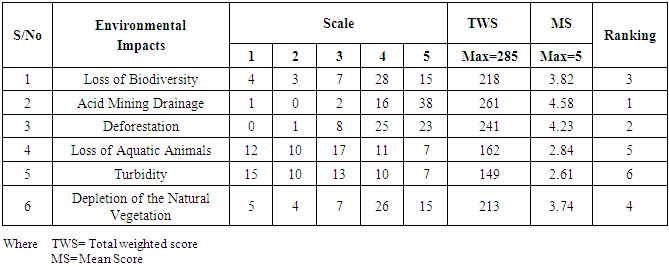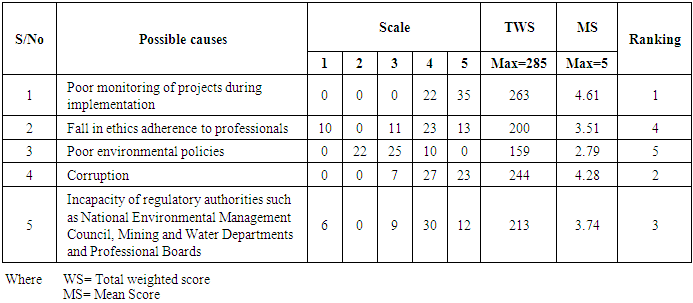-
Paper Information
- Paper Submission
-
Journal Information
- About This Journal
- Editorial Board
- Current Issue
- Archive
- Author Guidelines
- Contact Us
American Journal of Environmental Engineering
p-ISSN: 2166-4633 e-ISSN: 2166-465X
2017; 7(3): 65-72
doi:10.5923/j.ajee.20170703.03

Reliability of the Environmental Feasibility Studies to the Mining and Construction Projects: A Case of Mara River Basin in Tanzania
Benson Rugalema Mwemezi1, Valentine G. M. Luvara2
1Department Civil Engineering, Ardhi University, Dar es Salaam, Tanzania
2Department Building Economics, Ardhi University, Dar es Salaam, Tanzania
Correspondence to: Benson Rugalema Mwemezi, Department Civil Engineering, Ardhi University, Dar es Salaam, Tanzania.
| Email: |  |
Copyright © 2017 Scientific & Academic Publishing. All Rights Reserved.
This work is licensed under the Creative Commons Attribution International License (CC BY).
http://creativecommons.org/licenses/by/4.0/

This study investigates different predictions of environmental feasibility studies, identifies environmental impacts due to mining and construction activities, correlate the impact as predicted by the environmental feasibility studies with the actual impact on site and lastly recommends enhancement on the procedures of the environmental feasibility study, that if are practiced the Mara river basin will be better protected. This study was conducted in North Mara Goldmine and VIP lodge construction project in Mara region. Data were collected using document review, questionnaire, interviews and field observations using both convenience sampling and judgmental sampling. The study revealed loss of biodiversity, deforestation, high turbidity to water, presence of acid mine drainage and poor waste water management. It is thus recommended that monitoring during the project implementation should be done seriously by professionals adhering to their ethics and code of conducts. Source of construction materials specified should consider the impact to environment before giving out the building permit. Fully community involvement in preparation of the environmental feasibility studies is needed. There must be control of small scale mining activities. There must be an integrated water resources management plan for the conservation of water sources and lastly, construction and mining professionals should be more proactive in developing actions for the environment with a proper management approach to environmental assurance.
Keywords: Reliability, Environmental Feasibility Studies, Mining and Construction, Mara River Basin, Tanzania
Cite this paper: Benson Rugalema Mwemezi, Valentine G. M. Luvara, Reliability of the Environmental Feasibility Studies to the Mining and Construction Projects: A Case of Mara River Basin in Tanzania, American Journal of Environmental Engineering, Vol. 7 No. 3, 2017, pp. 65-72. doi: 10.5923/j.ajee.20170703.03.
Article Outline
1. Introduction
- Mara river basin is flowing through Kenya and Tanzania and it covers the surface area of 13,504 km2 of which 65% is located in Kenya and 35% in Tanzania. The river lies along Serengeti Masai Mara game reserve. ([1]). Along the Mara river basin there are different mining and construction projects that are carried out. These projects include the construction of hotel buildings and infrastructure to Serengeti national park and the mining activities which consist both large and small scale mining around the basin.According to the ([2]), the construction industry is a major source of the environmental problems. A number of construction and mining activities are environmentally not suitable partly due to lack of awareness of environmental sound practices and terminologies. It affects the environment through resource deterioration, physical disruption and chemical pollution.One of the requirement before the start of any new mining and construction project in any area is to do an environmental feasibility studies which include the environmental and social impact assessment (ESIA), environmental management plan and other parameters that will show the impact of such project to the environment. Along the Mara river basin there are a number of mining and construction projects that are taking place as part of the economic activities of the nation. Constructions of bridges, buildings and infrastructure as well as mining activities are among those projects. It has been observed that environment and wildlife in Mara river basin have been deteriorating time to time and as a result community in the basin is increasingly facing problems with poor water quality and environmental degradation ([3]) and this may be looked as the result of unreliable environmental feasibility studies to the projects that are carried out.
1.1. Environmental Impacts due to Mining and Construction Activities
- The following are the common environmental impact caused by mining and construction activities.
1.1.1. Loss of Biodiversity
- Extraction and processing of mineral resources plays a pivotal role in the national economy of many developed and developing countries of the world. However, various environmental problems caused by mineral exploitation such as biodiversity damage which includes habitat of the biodiversity and biodiversity itself ([4]). Mining activities has badly affected the biodiversity such as on soil cover, animals, birds, plant species etc. Unsustainable mining of natural resources have been a key factor for degradation of biodiversity. Vegetation in the forest areas have been under constant threat because of the unsustainable exploitation of the minerals ([5], [6]).
1.1.2. Acid Mining Drainage
- Mining activities remain as one of the most significant worldwide sources of acid mine into the environment due to the large volumes of released wastes, which usually affect relatively small areas of a given ecosystem, and in most cases, these wastes have a direct environmental degradation on coastal areas, far away from the mining operations ([7], [8]).
1.1.3. Deforestation
- To make mining possible, several forests are cleared and this leads to deforestation. The vegetation is cleared in order to build the mining facility and laying roads. Several organisms and animals live in these forests. With the deforestation, these organisms and animals lose their natural habitat. So, they start looking for a new habitat in order to survive. However, most organisms and animals do not respond very well to this change and end up dying. The biodiversity is lost in this process. A number of smaller plants and creepers that grow with the support of the trees also die due to deforestation ([6]).
1.1.4. Loss of Aquatic Animals
- While there is no scientific consensus on mercury contamination in the world, according to biologist, there is evidence of mercury causing problems in other ecosystems. Elemental or inorganic mercury can be transformed (methylated) into organic forms by biological systems and enter food chains. Not only are methylated mercury compounds toxic, but highly bio accumulative, meaning that mercury concentrations increase up the food chain. Top predators, including otters, birds of prey, and humans, will have the highest levels of mercury in their systems. Those who eat large amounts of fish are at the greatest risk ([9]).
1.1.5. Turbidity
- Turbidity in open water may be caused by growth of phytoplankton. Human activities that disturb land, such as construction, mining and agriculture, can lead to high sediment levels entering water bodies during rain storms due to storm water runoff. Areas prone to high bank erosion rates as well as urbanized areas also contribute large amounts of turbidity to nearby waters, through storm water pollution from paved surfaces such as roads, bridges and parking lots ([15]).
2. Methodology
2.1. Research and Sampling Design
- North Mara Goldmine and VIP lodge construction projects were selected as case studies areas. The research instruments for data collection were document review, questionnaire, interviews and observations using both convenience sampling and judgemental sampling. This research involved both quantitative and qualitative data.
2.2. Description of the Study Area
- The study was carried out in Musoma, Tanzania. Purposive sampling was used to select the North Mara goldmine and VIP lodge building slice factory to be the case studies. The villages such as Matongo, Nyangoto, Kerende, Kewanja, Nyakunguru, Weighita and Nyarwana as depicted in figure 1 were purposively selected as study area location since they are along the Mara river basin where the environmental depletion is happening due to the mining and construction activities [10].
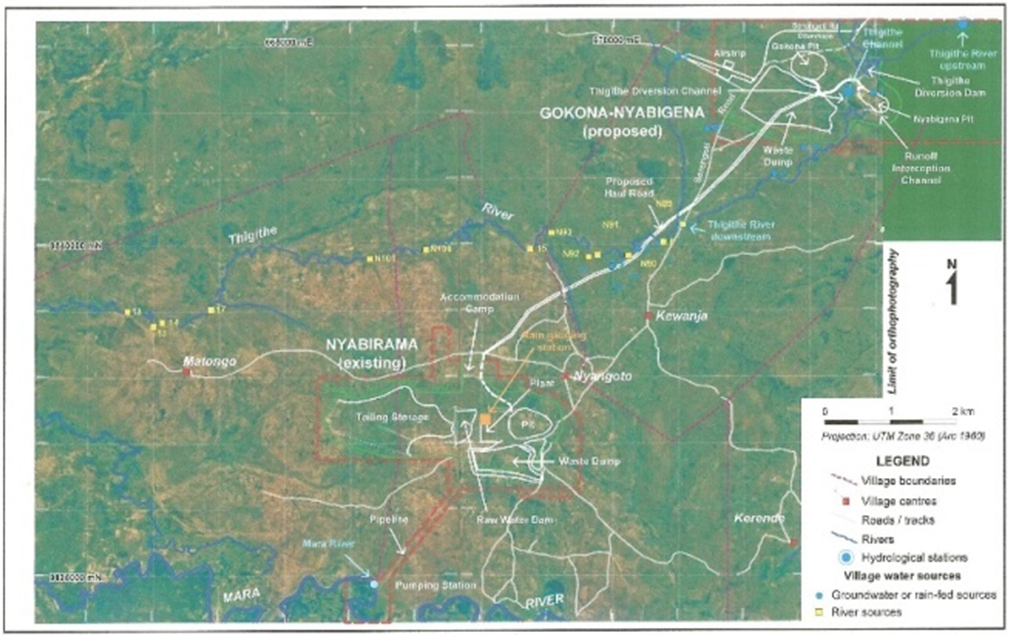 | Figure 1. A map showing some of the field sites observed (villages) - Source: SEMP (North Mara Gold Project) |
2.3. Data Collection
- By using different research instruments as discussed earlier, data were collected from the case studies i.e. from environmental manager of the North Mara goldmine and environmental coordinator of VIP lodge slate construction factory then data from the community around Mara river basin to seven villages as mentioned earlier. Generally data collected were the environmental impacts due to mining and construction activities along Mara river basin. Other data were collected from different authorities and stakeholders in environment, mining and construction industries, document review and field observation.
2.4. Data Analysis
- The analysis of qualitative data consisted of abstracting from raw data all points that a researcher had considered to be relevant to the topic under investigation. Using qualitative analysis the researcher has analysed the data thematically. Thematic analysis included analysis of words and concepts. All data from physical observations has been analysed using qualitative analysis of words by giving clarification and interpreting the features observed on projects with regard to Environmental Impacts due to mining and Construction Projects, Poor Involvement and Education to the Community and Performance of the Environmental Feasibility Studies as Predicted.Quantitative analysis uses the syntax of mathematical operations to investigate the properties of data ([11], [12]). In quantitative analysis the researcher has analysed the data statistically. Using descriptive statistics basic features of the data have been described and summarized. Descriptive statistics measure the central tendency. In order to determine possible causes of the different between the predictions of environmental feasibility study and actual situation on site, the respondents were asked to indicate their agreement or disagreement using 5 Likert scales (where 5 = strongly agree, 4 = agree, 3 = neutral, 2 = disagree and 1 = strongly disagree). The Study was done purposively on seven villages which are affected by the mining and construction projects and which are along the Mara river basin. These villages are Nyangoto, Matongo, Kewanja, Kerende, Nyakunguru, Weigitha and Nyarwana. In these villages the research purposively focused on the village chairpersons, leaders, village development members and the like. These composed of a population of 105 members. A sample of 57 members was purposively and conveniently selected.It follows that the researcher decided to establish a rank of impact and causes as per the responses obtained from the question. From each response, the researcher computed the total weighted score of the response in each impact and cause then calculated a mean score of each impact and cause so as to enable the researcher to rank each cause in order to determine the top most significant causes and the least ones. The total weighted score was computed from the equation:
 | (1) |
3. Results and Discussion (Findings and Data Analysis)
- Results in table 1 below shows the mean score of 4.58 which is making acid mine drainage ranked number one in the list of the environmental impacts due to mining and construction projects. This imply that respondents have experienced high acid mine drainage in their community due to mining activities at Mara river basin. Deforestation was ranked as the second environmental problem due to mining activities with a mean score of 4.23 followed by loss of biodiversity with 3.82 mean score. Other environmental impacts due to mining and construction activities includes Depletion of the Natural Vegetation, Loss of Aquatic Animals and Turbidity to Mara river Basin.
|
3.1. Environmental Impacts due to Mining and Construction Projects
- Observation on Environmental Impact due to Mining and Construction activitiesa) Loss of Biodiversity due to Mining worksFigure 2 Shows the exploited stones which have been exposed to different places, these stones cover the natural plants and other reptiles that are found in this area which make a loss on different natural plant and reptile species which cannot be restored in future. The area affected is approximately not less than 50 acres out of 4726.4 Km2.
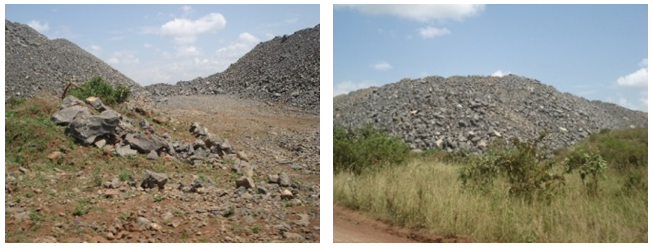 | Figure 2. Excavated rocks exposed at Kewanja - Source: Fieldwork survey at Kewanja; February 2017 |
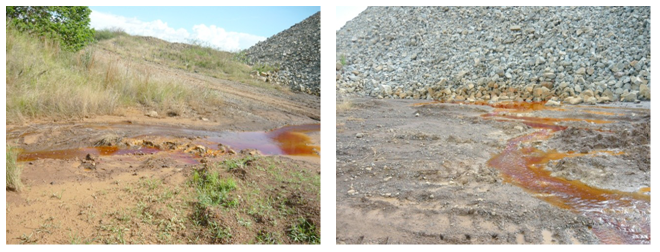 | Figure 3. Acid Mine Drainage (AMD) from Waste Rock piles at Nyabigena draining to the Environment (Source: [13]) |
 | Figure 4. Small Miners using Mercury to extract gold - Source: Fieldwork survey at Nyabigena; February 2017 |
 | Figure 5. Production of Rock Slice near river Somonche, used in Construction of VIP lodge and Mara River and Somonche River Confluence. Source: Fieldwork survey at Somonche; January 2017 |
3.2. Poor Involvement and Education to the Community
- From an interview with the North Mara goldmine environment department it is revealed that the issue of security and vandalism to different infrastructures such as the plastic carpets, pipes e.t.c was not well considered during the environmental feasibility study. The community were less involved and therefore poor education on the project infrastructures. This is evidenced by the habit of people from villages stealing and sabotage these important infrastructures that in one way or another cause leakages to some of the chemicals to the river and minimize the quality of water in the basin. An environmental feasibility study didn’t consider the security of the infrastructures that could be used to protect the environment. Figure 6 to 7 show some of vandalism of the different infrastructures which are causing the leakages of the chemicals to the river basin. Hence depletion of the water quality and wildlife conservation.
 | Figure 6. Stolen Plastic Carpets which is total Vandalism of Containment Dams - Source: Barrick North Mara goldmine |
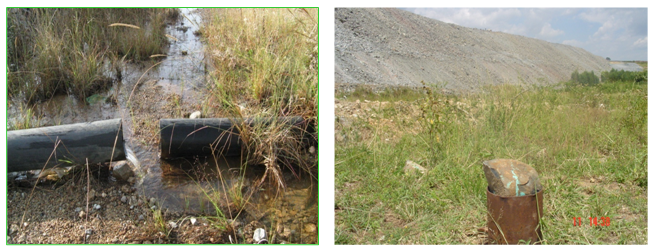 | Figure 7. Vandalized Pipes - Source: Barrick North Mara goldmine |
3.3. Performance of the Environmental Feasibility Studies as Predicted
- The data from National Environment Management Council shows that most of the environmental problems that are taking place in the mining and construction projects in Mara river basin have been well addressed in the environmental impact assessments and the environmental management plans for the particular projects which are the major input of the environmental feasibility study. For example in the environmental management plan of North Mara goldmine for Gokona showed that the management of acid rock drainage is the major issue for the development of the Nyabigena deposit, therefore they came up with the approach which involved a commitment to achieve compliance with Tanzania and WHO drinking water guidelines and at the first community water source downstream of the project area on the Thigithe River. To achieve this goal they were required to make commitment into:• Design, construct and manage the Gokona-Nyabigena waste dump according to best practice principles of acid drainage management.• Develop a comprehensive site water management plan to ensure that site drainage and pit dewatering waters are first contained and then released offsite in a controlled manner so as to prevent significant downstream impacts.• Develop a rehabilitation and closure plan for the site that minimises the long term environmental risk posed by the Gokona-Nyabigena waste dump and mine pits.All these were a very nice predictions to deal with the acid rock drainage and other environmental impacts but the situation on site of operation is very different because there are a lot of acid rock drainage that have been taking place in these mining areas at Mara river basin. Other predictions which were good but were not well implemented during the project execution include protection of surface water and ground water quality, protection of village water resources, community health, safety and amenity, protection of flora and fauna e.t.c all these were well addressed in the Environmental Management Plan (EMP) but the real situation on site is not as per the documented measures.The argument from the community along Mara river basin, 86 percent argue that there is a poor performance of the environmental feasibility studies whereas only 14 percent of respondents said that there is satisfactory performance. Furthermore, the community argued on which stage the environmental feasibility studies are failing and it revealed that all respondents ranked that the most critical level is during monitoring stage i.e. during project implementation followed by statutory regulations and requirements status enforcement while the other stages such as client brief/requirement stage, ESIA and EMP stages were the least critical stages.
3.4. Possible Causes of the Difference between the Predictions of Environmental Feasibility Study and Actual Situation on Site
- A sample of 57 members were purposively and conveniently selected out of the population of 105 members.From the results in table 2 it is revealed that there are different possible causes of the difference between the predictions and the actual operation on site for the environmental feasibility studies. All respondents agreed that the most significant cause is poor monitoring of projects during implementation with a mean score of 4.61 followed by corruption which was ranked the second with the mean score of 4.28. A very low capacity of power to discipline owners of projects which are destructing the environment from the respective regulatory authorities which are the National Environmental Management Council, Mining and Water departments and professional boards was seen as another factor that makes the gap between the predictions and the actual situation on site, this cause was ranked the third with a mean score of 3.74. The fourth significant cause was found to be fall in ethics adherence to professional with a mean score of 3.33 while poor environmental policies was found to be the least significant cause with a mean score of 2.79 in which respondents agreed this to have been a cause.
|
3.5. Challenges being faced by the Project Managers not to Implement the Environmental Feasibility Study
- From the opinion of the community, the project managers fail to implement well the environmental feasibility studies due to poor monitoring of the associated authorities such as environmental management council, Mining and water departments, professional boards regulating construction activities e.t.c, elements of corruption which make professionals fail doing their works properly. Another issue is lack of involvement of the community during different periodic environmental inspections it is sometime bringing the antagonism between the project management and the community. When people find the leakage of the acid mine it takes a very long time to tell the management of the project hence environmental problems in Mara river basin.Generally, lack of coordination among sectors and institutions is among factors that result in ineffective management of natural resources in most of basins in east Africa including Tanzania ([14]).
4. Conclusions and Recommendations
4.1. Conclusions
- The study revealed that there is unreliability of the environmental feasibility studies to the mining and construction projects under Mara river basin as shown in findings and data analysis of this study. The presence of many environmental impacts such as loss of biodiversity, deforestation, high turbidity to water, presence of acid mine drainage and poor waste water management that deplete the environment to the Mara river basin is an evidence to account for unreliability of the environmental feasibility studies to the mining and construction activities under Mara river basin. The study shows that during preparation of environmental feasibility studies, important issues like security are not well covered. For example in North Mara goldmine the issue of security of the different infrastructures such as plastic cover or carpets to the tailing dams were not well addressed in the environmental feasibility studies. Generally there is good predictions and management plans in the environmental feasibility studies such as on waste water management, acid mine drainage management, flora and fauna management e.t.c but the critical part of the unreliability of the environmental feasibility studies is on the monitoring during the work execution of the projects where everyone has to play his/her role to implement the predictions from the environmental feasibility studies but this is not done properly. Actually there is poor approaches in implementing the environmental feasibility studies to the different projects under Mara river basin due to the fact that most of the critical issues are all shown in the environmental feasibility studies and the management measures are well explained but project environmental project managers of the particular projects and other environmental authorities do not employ the laws and regulations positively in actual works, hence cause a very big depletion in the environment which lead to poor wild life conservation.
4.2. Recommendations
- On top of the observations and conclusions drawn, the researcher recommends the following towards best practice of the environmental feasibility study to different projects:-§ Monitoring during the project implementation should be done seriously by the professionals adhering to their ethics and code of conducts. In most projects the environmental feasibility studies are well done but the problem comes on when the monitoring authorities do not play their role effectively during the project execution. Since we have laws and regulations for protection of the environment, the punishments should be applied effectively and immediately for those who are not adhering to the law, furthermore the penalties should be increased. For this case the environmental management council and all Mining departments have a major role of monitoring the mining activities by bringing their professional to the site for a daily monitoring of the mining activities so as to protect the environment. § In construction projects, the materials that are being specified should be well checked by the relevant authorities. This is so because in the construction industry some of the specifications lead to destruction of the environment. All designers specifying building materials that deplete the environment the building permit should not be given to such a project. § During the preparations of the environmental feasibility studies there must be significant involvement of the community so that they can contribute on the different community matters that have to be considered. Less involvement of the community is dangerous because it attract the community to vandalism of the infrastructures such as waste pipes and plastic covers and thus cause depletion of the environment.§ Construction and mining professionals should be more proactive in developing actions for the environment. In order to achieve this, there is a need for a proper management approach environmental assurance. Traditional environmental management is a scientific control approach which focuses on the treatment of environmental destruction after the event. When an environmental problem has been caused, it will be far more expensive to remedy it. It is suggested that preventing the environment depletion is far more important than healing the results and this is the philosophy of environmental assurance. Environmental assurance is a “Causes” oriented policies, focusing on eliminating causes in the early stages rather than the “Results” oriented policies, focusing on recording and monitoring effects for environmental control as we have seen at River Tighite 2009 in Mara.§ There must be control of small scale mining activities by the provision of proper guidelines, technologies and the appropriate control mechanism by the relevant environmental authorities. For water disposal there must be an integrated water resources management plan for the conservation of water sources.§ Responsible authorities need to put in place the river conservation and protection plan and implementation framework so that anyone doing the projects which pollute the river be guided and asked to protect rivers at all stages of the project.
 Abstract
Abstract Reference
Reference Full-Text PDF
Full-Text PDF Full-text HTML
Full-text HTML